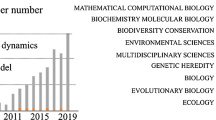Abstract
A fundamental theorem of mathematical demography states that two closed populations sharing the same extended history of net fertility, no matter how variable, have the same age composition. In consequence, when in any population net fertility has long followed a purely repetitive cycle, age composition must also be repetitive with the same cycle length. Under these conditions annual births follow a path that is an exponential multiplied by a periodic time-function. If the time variation of fertility is a small amplitude sinusoidal oscillation, the periodic component of the birth sequence is also sinusoidal. The relative amplitude and timing of fertility oscillations and the consequent birth fluctuations are functions of the duration (or frequency) of the fertility cycle; the nature of the functions is determined by the age structure of net fertility.Any time sequence of fertility variation over an extended period of time can be treated as if part of a repetitious cycle of very long duration. By Fourier analysis the fertility sequence can be expressed as the sum of a series of sinusoidal terms; and finally the sinusoidal components of the resultant birth sequence can be derived. The calculated birth sequence closely approximates the actual.
Similar content being viewed by others
References
Courant, R. 1937. Differential and Integral Calculus. New York: Interscience Publishers.
Keyfitz, Nathan. 1968. Introduction to the Mathematics of Population. Reading, Mass.: Addison-Wesley.
Keyfitz, Nathan and Wilhelm Fliegler. 1968. World Population: An Analysis of Vital Data. Chicago, Ill. and London, England: The University of Chicago Press.
Lopez, Alvaro. 1961. Problems in Stable Population Theory. Princeton: Office of Population Research.
—. 1967. Asymptotic Properties of a Human Age Distribution Under a Continuous Net Maternity Function. Demography 4: 680–687.
Lotka, Alfred J. 1939. Theorie Analytique des Associations Biologiques, Part II. Paris: Hermann et Cie.
— 1928. The Progeny of a Population Element. American Journal of Hygiene 8:875–90l.
McFarland, David D. 1969. On the Theory of Stable Populations: ANew and Elementary Proof of the Theorems Under Weaker Assumptions. Demography 6:301–322.
Author information
Authors and Affiliations
Rights and permissions
About this article
Cite this article
Coale, A.J. The use of fourier analysis to express the relation between time variations in fertility and the time sequence of births in a closed human population. Demography 7, 93–120 (1970). https://doi.org/10.2307/2060026
Issue Date:
DOI: https://doi.org/10.2307/2060026




